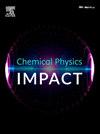Design, synthesis, structural characterization, in vitro anticancer activity, and in silico studies of some new hydroxylated and fluorinated-substituted hydrazone derivatives
IF 3.8
Q2 CHEMISTRY, PHYSICAL
引用次数: 0
Abstract
Today, due to improved lifestyles and increased survival, the number of new cancer cases and cancer-related deaths continues to increase. In this study, novel hydroxylated and fluorinated-substituted hydrazone derivatives bearing an aromatic nitro moiety (2a-d and 3a-d) were designed as potential anticancer drug candidates, synthesized for the first time, and evaluated for their anticancer activity against chondrosarcoma (SW1353), a common primary malignant cartilage-forming tumor, neuroblastoma (SH-SY5Y), a type of brain cancer, and healthy (L929) cell lines using the 3-(4,5-dimethylthiazol-2-yl)-2,5-diphenyl tetrazolium bromide (MTT) method for 24 h. The chemical structures of the target molecules were confirmed by FT-IR, 1D NMR (1H- and 13C- NMR, and APT), 2D NMR (COSY, HETCOR, and HMBC), and elemental analysis. Some of the compounds targeted against these cancer cell lines showed activity greater than 200 μM, whereas others (2d and 3a) demonstrated significant cytotoxic activity. Among them, compound 3a (IC50 = 9.45 ± 2.14 μM), a fluorinated-substituted hydrazone derivative, showed significant cytotoxic activity against the human SW1353 cell line compared to cisplatin (IC50 = 11.9 ± 0.95 μM). The anti-migratory properties of compounds 2d and 3a in SW1353 cells, were investigated. In particular, compound 3a exhibited anti-migration behavior in SW1353 cells, with a wound closure rate of 22.25 % compared with control cells. Further, scaffolds 2d and 3a exhibited the best docking with target receptor proteins 2OH4 (−8.3 and −8.4 kcal/mol) and 3QX3 (−12.2 and 11.0 kcal/mol), thereby supporting our bioactivity studies. Compounds 2a, 3a, 3b, and 3c showed high gastrointestinal (GI) absorption, with all except 3a being non-permeable to the blood-brain barrier (BBB). Most compounds, except 3d, are non-substrates of P-glycoprotein (P-gp). In conclusion, the in vitro and in silico results of some of the tested compounds indicate that they could be promising molecular frameworks for further studies.

一些新的羟基化和氟化取代腙衍生物的设计、合成、结构表征、体外抗癌活性和硅研究
今天,由于生活方式的改善和生存率的提高,新的癌症病例和与癌症有关的死亡人数继续增加。本研究首次合成了含有芳香硝基基团(2a-d和3a-d)的新型羟基化和氟化取代腙衍生物,作为潜在的抗癌候选药物,并评估了它们对软骨肉瘤(SW1353)(一种常见的原发性恶性软骨形成肿瘤)、神经母细胞瘤(SH-SY5Y)(一种脑癌)的抗癌活性。利用3-(4,5-二甲基噻唑-2-基)-2,5-二苯基溴化四氮唑(MTT)方法对健康(L929)细胞系进行24小时的分析。通过FT-IR、1D NMR (1H-和13C- NMR,以及APT)、2D NMR (COSY、hetor和HMBC)和元素分析证实了目标分子的化学结构。一些靶向这些癌细胞系的化合物显示活性大于200 μM,而其他化合物(2d和3a)显示出显著的细胞毒活性。其中含氟取代腙衍生物化合物3a (IC50 = 9.45±2.14 μM)对人SW1353细胞株的细胞毒活性显著高于顺铂(IC50 = 11.9±0.95 μM)。研究了化合物2d和3a在SW1353细胞中的抗迁移特性。特别是化合物3a在SW1353细胞中表现出抗迁移行为,与对照细胞相比,伤口愈合率为22.25%。此外,支架2d和3a与靶受体蛋白2OH4(- 8.3和- 8.4 kcal/mol)和3QX3(- 12.2和11.0 kcal/mol)的对接效果最好,从而支持了我们的生物活性研究。化合物2a、3a、3b和3c具有较高的胃肠道(GI)吸收,除3a外,其余化合物均不通过血脑屏障(BBB)。大多数化合物,除了3d,是p -糖蛋白(P-gp)的非底物。综上所述,一些被测化合物的体外和计算机实验结果表明,它们可能是有希望进一步研究的分子框架。
本文章由计算机程序翻译,如有差异,请以英文原文为准。
求助全文
约1分钟内获得全文
求助全文
来源期刊

Chemical Physics Impact
Materials Science-Materials Science (miscellaneous)
CiteScore
2.60
自引率
0.00%
发文量
65
审稿时长
46 days
 求助内容:
求助内容: 应助结果提醒方式:
应助结果提醒方式:


